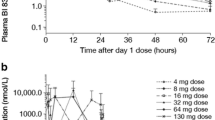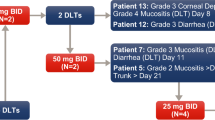Abstract
Purpose
Alisertib (MLN8237) is an investigational inhibitor of Aurora A kinase (AAK). Aurora A plays an essential role in the regulation of spindle assembly and chromosome alignment during mitosis. Inhibition of Aurora A by alisertib in tissue culture has previously been demonstrated to lead to improper chromosomal alignment and disruption of spindle organization, resulting in a transient mitotic delay. The spindle organization defects induced by alisertib have been used to develop a pharmacodynamic (PD) assay for Aurora A inhibition based on the percentage of mitotic cells with proper chromosomal alignment at the metaphase plate (% aligned spindles, abbreviated as AS). The transient mitotic delay that occurs with AAK inhibition permits the use of the mitotic index (the fraction of cells in the population currently undergoing mitosis, abbreviated as MI) as an additional PD assay. When the two PD assays were used in Phase I clinical trials, the reduction in AS was strongly correlated with dose levels and exposures in patients from single time point PD measurements; however, MI failed to show any correlation. To further understand this clinical finding, we constructed PK/PD/efficacy models for AS and MI that can precisely capture the temporal dynamics of the PD markers from in vivo xenograft studies.
Methods
A PK/PD study was conducted using a single oral dose of alisertib at 3, 10, and 20 mg/kg in HCT-116 xenografts implanted subcutaneously in mice. An extravascular, two-compartmental pharmacokinetic (PK) model was used to describe the drug kinetics. Consistent with the mechanistic hypothesis for AAK inhibition, the PD biomarkers such as AS and MI were fitted to PK using a direct response inhibitory sigmoid model and an indirect response turnover model, respectively. The antitumor activity of alisertib dosed orally for 21 days with different dose levels and schedules was evaluated.
Results
The PK/PD models showed a fast, sustained response for AS after alisertib administration, whereas MI exhibited a slow, transient response. The PK/efficacy relationship for alisertib in HCT-116 xenografts closely corresponds to the PK/PD relationship for the PD markers, with all three IC50s in close agreement (303, 270, and 280 nM, respectively).
Conclusion
The PK/PD and PK/efficacy models show that both AS and MI are equally relevant as mechanism-based PD markers to capture drug activity. However, of the two PD markers, the fast, sustained response of AS makes it the only clinically viable PD marker for defining a dose–response relationship, as its maximal effect can be captured from a wider time window with a single PD sampling; while the window to capture dose-related MI response is narrower.




Similar content being viewed by others
References
Marumoto T, Honda S, Hara T, Nitta M, Hirota T, Kohmura E, Saya H (2003) Aurora-A kinase maintains the fidelity of early and late mitotic events in HeLa cells. J Biol Chem 278(51):51786–51795
Marumoto T, Zhang D, Saya H (2005) Aurora-A—a guardian of poles. Nat Rev Cancer 5(1):42–50
Carmena M, Earnshaw WC (2003) The cellular geography of aurora kinases. Nat Rev Mol Cell Biol 4(11):842–854
Hirota T, Kunitoku N, Sasayama T, Marumoto T, Zhang D, Nitta M, Hatakeyama K, Saya H (2003) Aurora-A and an interacting activator, the LIM protein Ajuba, are required for mitotic commitment in human cells. Cell 114(5):585–598
Huck JJ, Zhang M, McDonald A, Bowman D, Hoar KM, Stringer B, Ecsedy J, Manfredi MG, Hyer ML (2010) MLN8054, an inhibitor of Aurora A kinase, induces senescence in human tumor cells both in vitro and in vivo. Mol Cancer Res 8(3):373–384
Manfredi MG, Ecsedy JA, Meetze KA, Balani SK, Burenkova O, Chen W, Galvin KM, Hoar KM, Huck JJ, LeRoy PJ, Ray ET, Sells TB, Stringer B, Stroud SG, Vos TJ, Weatherhead GS, Wysong DR, Zhang M, Bolen JB, Claiborne CF (2007) Antitumor activity of MLN8054, an orally active small-molecule inhibitor of Aurora A kinase. Proc Natl Acad Sci USA 104(10):4106–4111
Hoar K, Chakravarty A, Rabino C, Wysong D, Bowman D, Roy N, Ecsedy JA (2007) MLN8054, a small-molecule inhibitor of Aurora A, causes spindle pole and chromosome congression defects leading to aneuploidy. Mol Cell Biol 27(12):4513–4525
Manfredi MG, Ecsedy JA, Chakravarty A, Silverman L, Zhang M, Hoar KM, Stroud SG, Chen W, Shinde V, Huck JJ, Wysong DR, Janowick DA, Hyer ML, Leroy PJ, Gershman RE, Silva MD, Germanos MS, Bolen JB, Claiborne CF, Sells TB (2011) Characterization of Alisertib (MLN8237), an investigational small-molecule inhibitor of Aurora A kinase using novel in vivo pharmacodynamic assays. Clin Cancer Res 17(24):7614–7624
Cervantes A, Elez E, Roda D, Ecsedy J, Macarulla T, Venkatakrishnan K, Rosello S, Andreu J, Jung J, Sanchis-Garcia JM, Piera A, Blasco I, Manos L, Perez-Fidalgo JA, Fingert H, Baselga J, Tabernero J (2012) Phase I pharmacokinetic/pharmacodynamic study of MLN8237, an investigational, oral, selective Aurora A kinase inhibitor, in patients with advanced solid tumors. Clin Cancer Res 18(17):4764–4774
Dees EC, Cohen RB, von Mehren M, Stinchcombe TE, Liu H, Venkatakrishnan K, Manfredi M, Fingert H, Burris HA 3rd, Infante JR (2012) Phase I study of Aurora A kinase inhibitor MLN8237 in advanced solid tumors: safety, pharmacokinetics, pharmacodynamics, and bioavailability of two oral formulations. Clin Cancer Res 18(17):4775–4784
Macarulla T, Cervantes A, Elez E, Rodriguez-Braun E, Baselga J, Rosello S, Sala G, Blasco I, Danaee H, Lee Y, Ecsedy J, Shinde V, Chakravarty A, Bowman D, Liu H, Eton O, Fingert H, Tabernero J (2010) Phase I study of the selective Aurora A kinase inhibitor MLN8054 in patients with advanced solid tumors: safety, pharmacokinetics, and pharmacodynamics. Mol Cancer Ther 9(10):2844–2852
Dees EC, Infante JR, Cohen RB, O’Neil BH, Jones S, von Mehren M, Danaee H, Lee Y, Ecsedy J, Manfredi M, Galvin K, Stringer B, Liu H, Eton O, Fingert H, Burris H (2011) Phase 1 study of MLN8054, a selective inhibitor of Aurora A kinase in patients with advanced solid tumors. Cancer Chemother Pharmacol 67(4):945–954
Chakravarty A, Shinde V, Tabernero J, Cervantes A, Cohen RB, Dees EC, Burris H, Infante JR, Macarulla T, Elez E, Andreu J, Rodriguez-Braun E, Rosello S, von Mehren M, Meropol NJ, Langer CJ, ON B, Bowman D, Zhang M, Danaee H, Faron-Yowe L, Gray G, Liu H, Pappas J, Silverman L, Simpson C, Stringer B, Tirrell S, Veiby OP, Venkatakrishnan K, Galvin K, Manfredi M, Ecsedy JA (2011) Phase I assessment of new mechanism-based pharmacodynamic biomarkers for MLN8054, a small-molecule inhibitor of Aurora A kinase. Cancer Res 71(3):675–685
Mager DE, Wyska E, Jusko WJ (2003) Diversity of mechanism-based pharmacodynamic models. Drug Metab Dispos 31(5):510–518
Derendorf H, Meibohm B (1999) Modeling of pharmacokinetic/pharmacodynamic (PK/PD) relationships: concepts and perspectives. Pharm Res 16(2):176–185
Wysong DR, Chakravarty A, Hoar K, Ecsedy JA (2009) The inhibition of Aurora A abrogates the mitotic delay induced by microtubule perturbing agents. Cell Cycle 8(6):876–888
Sudakin V, Yen TJ (2007) Targeting mitosis for anti-cancer therapy. BioDrugs 21(4):225–233
Green MC, Buzdar AU, Smith T, Ibrahim NK, Valero V, Rosales MF, Cristofanilli M, Booser DJ, Pusztai L, Rivera E, Theriault RL, Carter C, Frye D, Hunt KK, Symmans WF, Strom EA, Sahin AA, Sikov W, Hortobagyi GN (2005) Weekly paclitaxel improves pathologic complete remission in operable breast cancer when compared with paclitaxel once every 3 weeks. J Clin Oncol 23(25):5983–5992
Sparano JA, Wang M, Martino S, Jones V, Perez EA, Saphner T, Wolff AC, Sledge GW Jr, Wood WC, Davidson NE (2008) Weekly paclitaxel in the adjuvant treatment of breast cancer. N Engl J Med 358(16):1663–1671
Furman WL, Stewart CF, Poquette CA, Pratt CB, Santana VM, Zamboni WC, Bowman LC, Ma MK, Hoffer FA, Meyer WH, Pappo AS, Walter AW, Houghton PJ (1999) Direct translation of a protracted irinotecan schedule from a xenograft model to a phase I trial in children. J Clin Oncol 17(6):1815–1824
Testart-Paillet D, Girard P, You B, Freyer G, Pobel C, Tranchand B (2007) Contribution of modelling chemotherapy-induced hematological toxicity for clinical practice. Crit Rev Oncol Hematol 63(1):1–11
Liu Q, Ruderman JV (2006) Aurora A, mitotic entry, and spindle bipolarity. Proc Natl Acad Sci USA 103(15):5811–5816
Tyler RK, Shpiro N, Marquez R, Eyers PA (2007) VX-680 inhibits Aurora A and Aurora B kinase activity in human cells. Cell Cycle 6(22):2846–2854
Dutertre S, Descamps S, Prigent C (2002) On the role of Aurora-A in centrosome function. Oncogene 21(40):6175–6183
Cimini D, Moree B, Canman JC, Salmon ED (2003) Merotelic kinetochore orientation occurs frequently during early mitosis in mammalian tissue cells and error correction is achieved by two different mechanisms. J Cell Sci 116(Pt 20):4213–4225
Cimini D (2008) Merotelic kinetochore orientation, aneuploidy, and cancer. Biochim Biophys Acta 1786(1):32–40
Cimini D, Wan X, Hirel CB, Salmon ED (2006) Aurora kinase promotes turnover of kinetochore microtubules to reduce chromosome segregation errors. Curr Biol 16(17):1711–1718
Thompson SL, Compton DA (2011) Chromosome missegregation in human cells arises through specific types of kinetochore-microtubule attachment errors. Proc Natl Acad Sci USA 108(44):17974–17978
Cimini D, Howell B, Maddox P, Khodjakov A, Degrassi F, Salmon ED (2001) Merotelic kinetochore orientation is a major mechanism of aneuploidy in mitotic mammalian tissue cells. J Cell Biol 153(3):517–527
Salmon ED, Cimini D, Cameron LA, DeLuca JG (2005) Merotelic kinetochores in mammalian tissue cells. Philos Trans R Soc Lond B Biol Sci 360(1455):553–568
Cimini D (2007) Detection and correction of merotelic kinetochore orientation by Aurora B and its partners. Cell Cycle 6(13):1558–1564
Acknowledgments
We thank the members of the Drug Metabolism and Pharmacokinetics department at Millennium for helpful discussions.
Conflict of interest
All the authors are current or former employees/contractors of Millennium: The Takeda Oncology Company.
Author information
Authors and Affiliations
Corresponding author
Electronic supplementary material
Below is the link to the electronic supplementary material.
Rights and permissions
About this article
Cite this article
Palani, S., Patel, M., Huck, J. et al. Preclinical pharmacokinetic/pharmacodynamic/efficacy relationships for alisertib, an investigational small-molecule inhibitor of Aurora A kinase. Cancer Chemother Pharmacol 72, 1255–1264 (2013). https://doi.org/10.1007/s00280-013-2305-8
Received:
Accepted:
Published:
Issue Date:
DOI: https://doi.org/10.1007/s00280-013-2305-8




